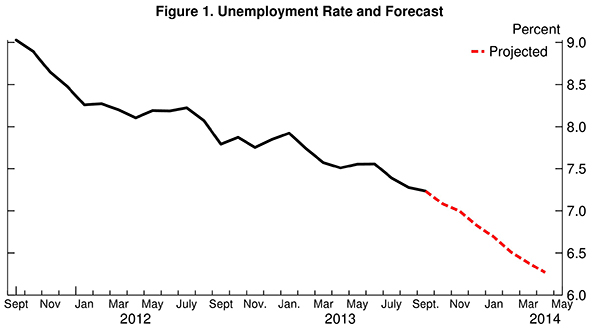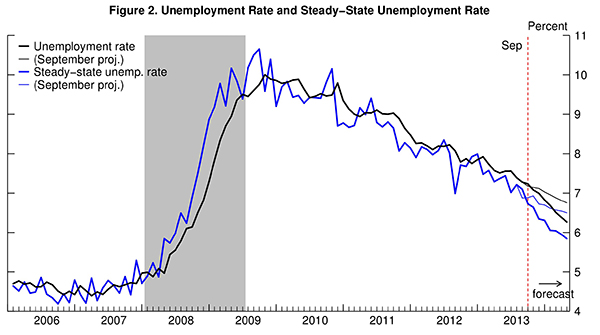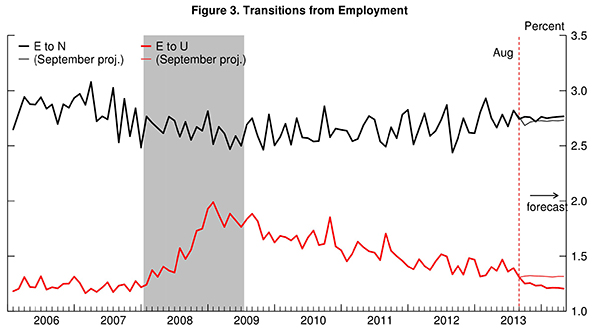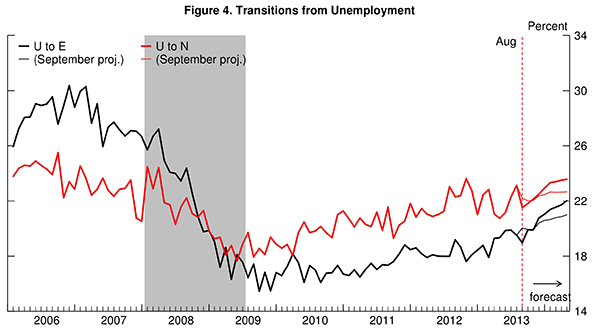Unemployment should decline by more than 0.1 percent per month over the next six months and to fall below 6.5 percent—the Fed’s unemployment threshold—by February 2014.
This post discusses my monthly update of the Barnichon-Nekarda model. For an introduction to the basic concepts used in this post, read my introductory post (Full details are available here.)
In September, the unemployment rate dropped to 7.2 percent—as the model correctly predicted (again!) last month—pushed down by the steady-state convergence dynamics. The decline in unemployment will continue, with a 7.1 percent jobless rate expected for October, and the outlook for the next 6 months is good: following positive readings on the job openings and layoffs fronts, the steady-state unemployment rate currently stands at 6.7percent and is expected to decline strongly over the next couple months and reach 5.9percent by March 2014, which will translate into an unemployment declining by more than 0.1 percentage points per month over the next six months. At this rate, the unemployment rate would fall below 6.5percent—the threshold unemployment rate above which the Fed has vowed to hold interest rates near zero—by February 2014.

This forecast is easily understood by looking at the projected behavior of the “steady-state” unemployment rate. The steady-state unemployment rate, or the rate of unemployment implied by the underlying labor force flows—the blue line in figure 2—stands currently at 6.7percent. Our research shows that the actual unemployment rate converges toward this steady state. With a steady-state unemployment rate lower level than the actual rate (6.7 versus 7.2, a 0.5 percentage point difference), this “steady-state convergence dynamic” is pushing the unemployment rate down, implying a decline in unemployment going forward. Moreover, the model anticipates the steady-state unemployment rate (SSUR) to decline strongly (and much more than anticipated as of last month) over the coming month (figure 2). As a result, the gap between the unemployment rate and SSUR will remain roughly constant at about 0.5ppt over the next 6 months, and the steady-state convergence dynamic will remain strong, pushing the unemployment rate down over the next 6 months.

To forecast the behavior of steady-state unemployment (and hence of the actual unemployment rate), the model propagates forward its best estimate for how the flows between employment, unemployment and out-of-the labor force will evolve over time. The strong increase in job openings (the largest monthly increase in more than a year) in September and the strong decline in new claims for unemployment insurance (again, the largest monthly decrease in more than a year) are interpreted by the models as signaling (i) a strong increase in workers’ job finding rate going forward (figure 4), and (ii) a strong decrease in workers’ job separation rate (mostly layoffs, figure 3). Both forces translate into a strongly decreasing SSUR, and thus a decreasing unemployment rate.



To read more about the underlying model and the evidence that it outperforms other unemployment rate forecasts, see Barnichon and Nekarda (2012).



Commentary
Good News On The Labor Market Front! Unemployment to Steadily Drop Over Next 6 Months
November 7, 2013